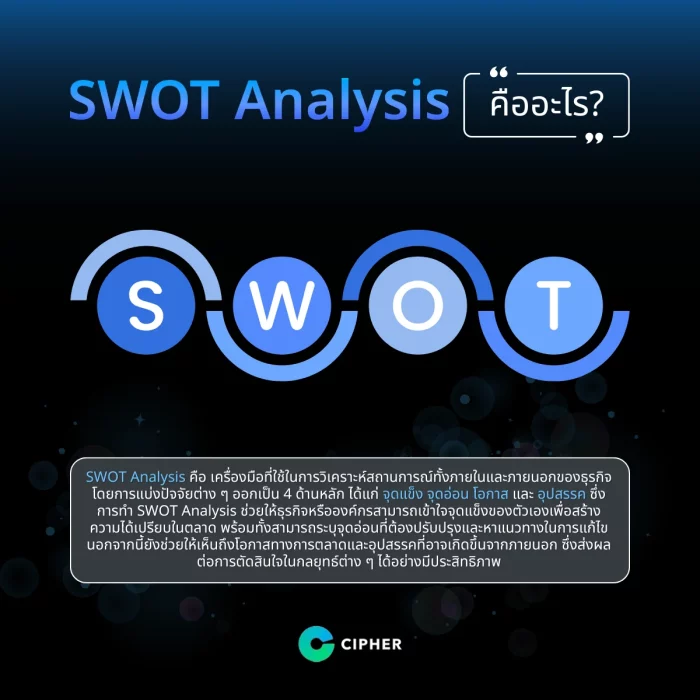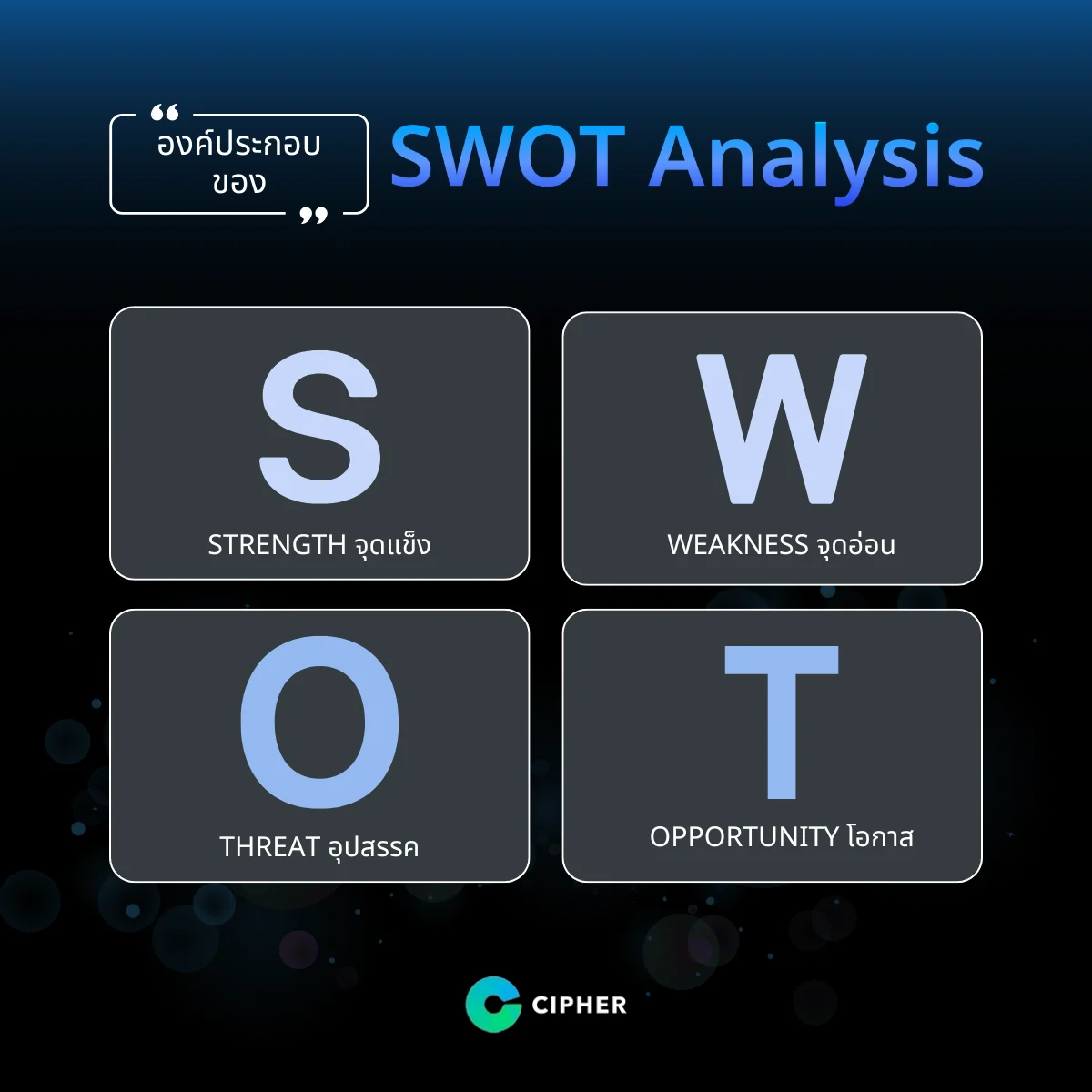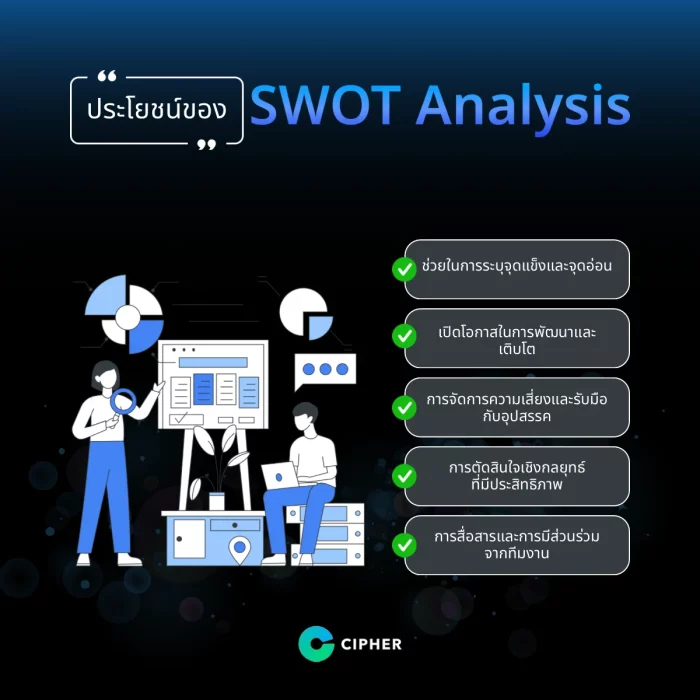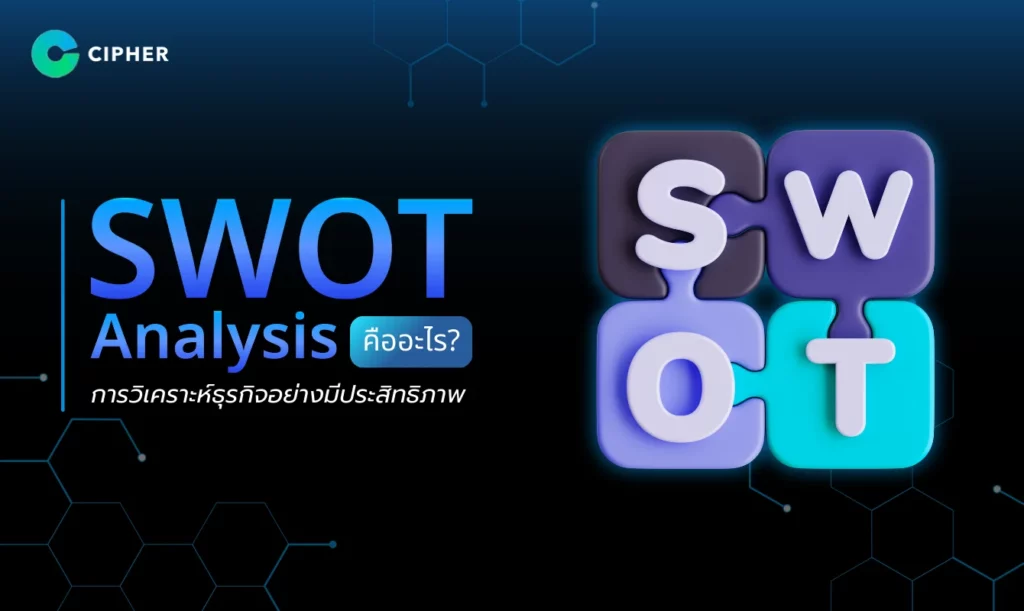Table of Contents
What is SWOT Analysis? How is it useful for businesses?
What is SWOT Analysis? This is a question that many businesses wonder when starting to analyze internal and external factors. By assessing the strengths, weaknesses, opportunities and obstacles that affect the business To develop marketing strategies and campaigns Whether it is sending Email Marketing with CRM or doing Email Marketing, you can use this concept to develop a successful marketing strategy.
So in this article, we will talk about what SWOT is? And the benefits that help businesses create marketing campaigns That will help increase your business competitiveness to be on par with competitors!
What is SWOT Analysis?

SWOT Analysis is a tool used to analyze the internal and external situations of a business by dividing into four key areas: strengths, weaknesses, opportunities and obstacles. SWOT Analysis enables businesses or organizations to understand their strengths to gain market advantage, identify weaknesses that need to be improved and find solutions. In addition, it also helps to identify potential market opportunities and external obstacles, which effectively affect the decision making of various strategies.
SWOT analysis is a useful tool for planning business strategies, whether it’s deciding on new product development, pricing, channel selection, or sales promotion. By using information from SWOT analysis, businesses can prioritize strategies that should be implemented and adapt strategies to market changes.
What does SWOT Analysis mean?
SWOT Analysis refers to tools used to analyze the situation or business environment to help plan and make strategic decisions by evaluating both internal and external factors that may affect the business in the future. SWOT analysis is what will help businesses or organizations to gain advantages and address potential risks or obstacles. The main components are as follows:

S - Strength, Strength.
SWOT Analysis’s S refers to strength, an internal factor that gives businesses or organizations a competitive edge and enables market success. Strengths can be valuable resources, special skills, or difficult to emulate, such as high quality products, excellent customer service or a well-known brand. Identifying strengths enables businesses to adopt effective strategies to increase their competitiveness and attract customers.
W-Weakness is a weakness.
SWOT’s W, Weakness, refers to weaknesses, which are internal factors that cause businesses or organizations to be limited or unable to compete effectively. The weaknesses can be caused by lack of certain skills or resources such as poor management. Lack of R&D or lack of market capability. Identifying weaknesses in the organisation enables solutions and improvements to better compete in the market and mitigate the potential risks of these shortcomings.
O - Opportunity Opportunity
SWOT’s O Opportunity means opportunities, or external factors that can contribute to business growth or benefits, such as changes in market trends or technology development that can benefit businesses. These opportunities can be attributed to changes in consumer behaviour or changes in the business-friendly economy. And good opportunities will help businesses expand their customer base and increase revenue.
T-Threat the Obstacle
SWOT’s T is Threat, which is an external factor that may harm or affect business growth and success. These obstacles can come from changes in the economy, heightened competition, changes in law or changes in consumer behavior that businesses may not be predictable, perceived obstacles. It allows businesses to prepare and adapt to situations to avoid potential risks or impacts and to find ways to cope with them.
How SWOT benefits the organization? Any?

SWOT Analysis is a tool that has many benefits for an organization that enables businesses or organizations to effectively plan and make decisions. Key benefits can be summarized as follows:
be helpful in identifying strengths and weaknesses
SWOT enables organizations to assess and identify their strengths, such as resources with special skills or competitiveness, as well as search for potential weaknesses, such as resource shortages, mismanagement, or system flaws, enabling business development and improvement.
open up opportunities for development and growth
Opportunities from the external environment allow organizations to see market trends or new growth channels, such as technology changes or customer expansion. Identifying these opportunities allows organizations to plan strategies to take advantage of opportunities.
Managing Risk and Meeting Obstacles
Threats enable organizations to recognize and prepare for external challenges or risks, such as intense competition, regulatory changes, or changes in consumer behaviour. Recognition of obstacles helps organizations find ways to adapt and mitigate their impact.
an effective strategic decision
SWOT enables organizations to make effective decisions by analyzing data from both internal and external organizations, enabling businesses to determine the most appropriate strategies in terms of product development, pricing, sales channels, and operational improvements to improve efficiency.
communication and participation from the team
SWOT enables good communication within the organisation by collaborating with teams to analyze strengths, weaknesses, opportunities and obstacles, enabling them to understand and participate in strategic planning, enabling consistent operations and efficient operation.
SWOT restrictions are available. Anything?
Although SWOT Analysis is a useful tool for analyzing business situations, there are some limitations that may make the use of this tool incomplete or unable to produce the best results in some cases as follows:
- Analysis may lack depth: SWOT may not be able to provide sufficient in-depth information to analyze complex situations, additional tools are required to complement the analysis.
- Interpretation of non-biased data: Analysis may be affected by individual perspectives or team bias, which may make data assessment non-biased.
Not considering long-term effects: SWOT usually only views current and short-term situations without being able to anticipate or analyze long-term effects. - Unable to distinguish relationships between components: SWOT does not show a link between strengths, weaknesses, opportunities, and obstacles. It does not provide a complete overview. For example, certain weaknesses may hinder the use of strengths.
- Not suitable for complex situations: In case of multiple factors or complex situations, SWOT may not be able to provide sufficient analysis, such as fast-changing markets, other analytical tools may be required along with precision.
What are the steps of SWOT Analysis? ?
Step 1: Gather information, set up SWOT Analysis Team
The first step in SWOT Analysis is to collect the data required for analysis and to set up a diverse and comprehensive analysis team that covers all departments of the organization, such as marketing teams, product teams, sales or management.
Teams should have different skills and perspectives so that the analysis is diverse and round-robin. The data collected may be from interviews, surveys, or studies on competitors and markets, as well as customer data from the CRM system to identify the four components of SWOT.
Step 2: Determine the purpose and scope of the analysis.
The next step is to define SWOT Analytics objectives, such as creating leads, expanding markets, developing new products, or improving customer service. Setting clear objectives will help determine the direction and decision making of the organization by leveraging CRM or all data collected for analysis. To ensure that only key factors are highlighted and relevant to the core business objectives.
Step 3: Evaluate internal and external factors
At this stage, the analyst team assess internal factors, corporate strengths and weaknesses and external factors, opportunities and obstacles from the market or competitor. By studying and analyzing collected data to understand the business overview, strengths can involve valuable resources such as technology or special skills, while weaknesses can be resource constraints or improper processes. At the same time, opportunities and obstacles will come from changes in the market or laws affecting business.
Step 4: Prioritize factors
Once strengths, weaknesses, opportunities, and obstacles are identified, the next step is to prioritize each factor so that strategic planning is clear and practical. Priorities allow for focus on the most important factors, such as addressing weaknesses that affect growth or using strengths to cope with emerging challenges.
Step 5: Create a Plan and Implementation Strategy
The final step is to create a roadmap by using SWOT analysis results, establishing appropriate strategies to leverage strengths, address weaknesses, addressing potential challenges, and addressing potential business challenges. The roadmap should include details on how to implement, goals to achieve, implementation times, and metrics used to evaluate the success of the strategies presented.
In addition, preparation for staff training should not be overlooked. For example, the CRM training will enable the application of the CRM system to be applied to SWOT analysis more completely and accurately.
SWOT Analysis Example
In order to better visualize SWOT analysis, we would like to give an example of SWOT analysis for Thai restaurants in Thailand to better understand how they work.
Sample Business with SWOT Analysis
Strengths (Strengths)
- Various Thai menus: The restaurant offers a variety of Thai menus with unique flavors, attracting both Thai and foreign customers.
- High-quality raw materials: Using fresh and high-quality ingredients in cooking, the taste of fresh food is refreshing and is loved by customers.
- Good location: The store is located in a crowded area, such as near tourist attractions or shopping centers, making it easy to reach customers.
- Popularity in Thai food: Thai food is popular all over the world, especially among foreign tourists, giving the restaurant the opportunity to attract foreign customers.
Weaknesses (Weaknesses)
- Prices are quite high: Some Thai restaurants may have higher prices compared to regular restaurants, making it impossible to attract customers with low purchasing power.
- Dependence on local customers: The store may rely on local customers who are familiar with the taste of Thai food and cannot expand their customer base significantly among tourists.
- Lack of online delivery service: Failure to support online delivery can be an obstacle for customers who want to order food from home or those who are inconvenient to come to the store.
- Stock and raw materials management: As restaurants require fresh raw materials, efficient inventory management can be challenging, especially during the time of a shortage of raw materials.
Opportunities
- Expansion into overseas markets: With the popularity of Thai food abroad, expansion of branches overseas may be an opportunity to increase income.
- Online delivery: Joining online food delivery platforms such as Grab Food and Foodpanda will help the store reach new customers who cannot visit the store.
- Health Focus: Adjusting menus to serve the trend of healthy eating, such as fresh vegetables and low-calorie menus can attract new customers.
- Social media promotion: Using social media to promote the store can create greater awareness and stimulate visits to the store, especially among online customers.
Obstacles (Threats)
- Competition from other restaurants: The restaurant market in Thailand is highly competitive, especially in restaurants that are inexpensive and of good quality.
- Changes in consumer behaviour: The popularity of convenient and affordable fast food may be a hindrance to attracting Thai restaurants.
- Uncertain economic conditions: A sluggish economy or a decline in tourism may cause restaurants to experience difficulties in sales and profits.
- Transportation and logistics problems: The problem of delayed shipments of raw materials or food delivery may cause dissatisfaction with customers and adversely affect the reputation of the store.
Results obtained from SWOT analysis
According to the SWOT analysis of Thai restaurants, it was found that
- The store has strengths in the use of quality materials and a variety of menus that make it attractive in the market, but it also has weaknesses in high prices and lack of online delivery services.
- There are opportunities to expand domestic and international markets, especially by using online platforms to increase sales channels.
- The main obstacles facing restaurants are high competition in the restaurant market and changing consumer behaviour toward more convenient and cheaper food.
So given the understanding that SWOT is What and the process will provide an overview of SWOT Analysis. This will help businesses to find solutions and improve strategies such as improving online delivery services to facilitate customers, adjusting prices or increasing affordable menu options to attract customers with limited purchasing power.
In addition, the use of social media and online marketing to promote the store and create awareness among the tourist and local customers will allow businesses to differentiate and create more sales opportunities.
Summary
SWOT is… What? SWOT Analytics is a key tool for analyzing the strengths, weaknesses, opportunities and obstacles of the business, enabling companies to make effective decisions and strategies that fit the situation in terms of product development, market expansion, or internal process improvement. SWOT analytics will provide businesses with useful features and opportunities. And address the weaknesses and obstacles to business growth.
If you are looking for new ways to improve and strengthen customer relationships or improve your marketing strategies, CHIPHER will also provide CRM and email marketing services that can help you build a positive customer experience and enhance business communication. You can contact us to discuss and find solutions that suit your business!
Frequently Asked Questions
When understanding SWOT Analysis is What? I believe that many people want to apply this idea to the organization and to better understand SWOT’s origins, we have compiled common questions and found answers for you.
SWOT analysis is available. Anything?
SWOT Analysis refers to a tool for analyzing a business situation, which consists of four components:
- Strengths: Points used to consider, such as what are the advantages that exist over competitors.
- Weaknesses (weaknesses): Issues used in consideration, such as what people around them think needs improvement.
- Opportunities: Issues that are considered such as external changes that benefit the business or interesting trends.
- Threats: Issues that are used to consider, such as external changes that are obstacles to the business or competitors are doing. What will affect the future?
What does SWOT write?
SWOT Analysis’s S-W-O-T refers to four English letters that come together as follows:
- S – (Strengths – Strengths): Highlights within the company that enable competition, such as the availability of quality products or the availability of capable human resources.
- W – (Weaknesses – Weaknesses): Problems or defects within the company that may hinder growth, such as lack of skills, backward production systems or lack of effective marketing.
- O – (Opportunities – Opportunities): External factors that benefit or promote business operations such as new market growth or technological changes.
- T – (Threats – Obstacles): External factors that may hinder business such as high competition, changes in laws or economic crisis.
What should the correct SWOT analysis do?
The right SWOT analysis helps to understand the business status and can create effective strategies, starting with:
- Establish objectives: Identify the goals of the analysis, such as developing a marketing strategy or evaluating the business.
- In-house analysis: Based on identifying strengths such as resources, expertise or strong brands, and weaknesses such as lack of capital, slow service or inefficient processes.
- Out-of-Organization Analysis: Analysis based on opportunities such as new market expansion or efficiency-enhancing technologies and identification of obstacles such as high competition or economic changes.
- Collect data from multiple sources: use internal and external data such as market data, customer feedback and in-house surveys.
- Prioritize: Rank strengths, weaknesses, opportunities, and obstacles according to their importance level.
- Develop strategies from SWOT: Use the information obtained from SWOT to create strategies and find solutions for each point, such as S-O, using strengths to increase opportunities, or W-O using opportunities to address weaknesses.
- Monitoring and evaluating: Continuously evaluate strategy results to adapt strategy to changing environments.
SWOT contains metrics. Anything?
The metrics for SWOT analysis are: SWOT is the four components of SWOT Analysis as follows:
- Strength assessment: It is an internal factor such as the quality of products and resources available.
- Weaknesses assessment: are internal factors such as financial constraints or non-modern processes.
- Opportunities assessment: external factors such as growth in new markets or the use of new technologies.
- Barriers assessment (Threats): are external factors such as changes in the economy.


![{"type":"elementor","siteurl":"https://www.cipher.co.th/wp-json/","elements":[{"id":"f53b9ef","elType":"widget","isInner":false,"isLocked":false,"settings":{"image":{"url":"https://www.cipher.co.th/wp-content/uploads/2025/01/ปรึกษาการใช้งาน-2.png","id":8654,"size":"","alt":"","source":"library"},"image_size":"large","image_custom_dimension":{"width":"","height":""},"caption_source":"none","caption":"","link_to":"none","link":{"url":"","is_external":"","nofollow":"","custom_attributes":""},"open_lightbox":"default","align":"","align_tablet":"","align_mobile":"","width":{"unit":"%","size":"","sizes":[]},"width_tablet":{"unit":"%","size":"","sizes":[]},"width_mobile":{"unit":"%","size":"","sizes":[]},"space":{"unit":"%","size":"","sizes":[]},"space_tablet":{"unit":"%","size":"","sizes":[]},"space_mobile":{"unit":"%","size":"","sizes":[]},"height":{"unit":"px","size":"","sizes":[]},"height_tablet":{"unit":"px","size":"","sizes":[]},"height_mobile":{"unit":"px","size":"","sizes":[]},"object-fit":"","object-fit_tablet":"","object-fit_mobile":"","object-position":"center center","object-position_tablet":"","object-position_mobile":"","opacity":{"unit":"px","size":"","sizes":[]},"css_filters_css_filter":"","css_filters_blur":{"unit":"px","size":0,"sizes":[]},"css_filters_brightness":{"unit":"px","size":100,"sizes":[]},"css_filters_contrast":{"unit":"px","size":100,"sizes":[]},"css_filters_saturate":{"unit":"px","size":100,"sizes":[]},"css_filters_hue":{"unit":"px","size":0,"sizes":[]},"opacity_hover":{"unit":"px","size":"","sizes":[]},"css_filters_hover_css_filter":"","css_filters_hover_blur":{"unit":"px","size":0,"sizes":[]},"css_filters_hover_brightness":{"unit":"px","size":100,"sizes":[]},"css_filters_hover_contrast":{"unit":"px","size":100,"sizes":[]},"css_filters_hover_saturate":{"unit":"px","size":100,"sizes":[]},"css_filters_hover_hue":{"unit":"px","size":0,"sizes":[]},"background_hover_transition":{"unit":"px","size":"","sizes":[]},"hover_animation":"shrink","image_border_border":"","image_border_width":{"unit":"px","top":"","right":"","bottom":"","left":"","isLinked":true},"image_border_width_tablet":{"unit":"px","top":"","right":"","bottom":"","left":"","isLinked":true},"image_border_width_mobile":{"unit":"px","top":"","right":"","bottom":"","left":"","isLinked":true},"image_border_color":"","image_border_radius":{"unit":"px","top":"","right":"","bottom":"","left":"","isLinked":true},"image_border_radius_tablet":{"unit":"px","top":"","right":"","bottom":"","left":"","isLinked":true},"image_border_radius_mobile":{"unit":"px","top":"","right":"","bottom":"","left":"","isLinked":true},"image_box_shadow_box_shadow_type":"","image_box_shadow_box_shadow":{"horizontal":0,"vertical":0,"blur":10,"spread":0,"color":"rgba(0,0,0,0.5)"},"caption_align":"","caption_align_tablet":"","caption_align_mobile":"","text_color":"","caption_background_color":"","caption_typography_typography":"","caption_typography_font_family":"","caption_typography_font_size":{"unit":"px","size":"","sizes":[]},"caption_typography_font_size_tablet":{"unit":"px","size":"","sizes":[]},"caption_typography_font_size_mobile":{"unit":"px","size":"","sizes":[]},"caption_typography_font_weight":"","caption_typography_text_transform":"","caption_typography_font_style":"","caption_typography_text_decoration":"","caption_typography_line_height":{"unit":"em","size":"","sizes":[]},"caption_typography_line_height_tablet":{"unit":"em","size":"","sizes":[]},"caption_typography_line_height_mobile":{"unit":"em","size":"","sizes":[]},"caption_typography_letter_spacing":{"unit":"px","size":"","sizes":[]},"caption_typography_letter_spacing_tablet":{"unit":"px","size":"","sizes":[]},"caption_typography_letter_spacing_mobile":{"unit":"px","size":"","sizes":[]},"caption_typography_word_spacing":{"unit":"em","size":"","sizes":[]},"caption_typography_word_spacing_tablet":{"unit":"em","size":"","sizes":[]},"caption_typography_word_spacing_mobile":{"unit":"em","size":"","sizes":[]},"caption_text_shadow_text_shadow_type":"","caption_text_shadow_text_shadow":{"horizontal":0,"vertical":0,"blur":10,"color":"rgba(0,0,0,0.3)"},"caption_space":{"unit":"px","size":"","sizes":[]},"caption_space_tablet":{"unit":"px","size":"","sizes":[]},"caption_space_mobile":{"unit":"px","size":"","sizes":[]},"_title":"","_margin":{"unit":"px","top":"","right":"","bottom":"","left":"","isLinked":true},"_margin_tablet":{"unit":"px","top":"","right":"","bottom":"","left":"","isLinked":true},"_margin_mobile":{"unit":"px","top":"","right":"","bottom":"","left":"","isLinked":true},"_padding":{"unit":"px","top":"","right":"","bottom":"","left":"","isLinked":true},"_padding_tablet":{"unit":"px","top":"","right":"","bottom":"","left":"","isLinked":true},"_padding_mobile":{"unit":"px","top":"","right":"","bottom":"","left":"","isLinked":true},"_element_width":"","_element_width_tablet":"","_element_width_mobile":"","_element_custom_width":{"unit":"%","size":"","sizes":[]},"_element_custom_width_tablet":{"unit":"px","size":"","sizes":[]},"_element_custom_width_mobile":{"unit":"px","size":"","sizes":[]},"_grid_column":"","_grid_column_tablet":"","_grid_column_mobile":"","_grid_column_custom":"","_grid_column_custom_tablet":"","_grid_column_custom_mobile":"","_grid_row":"","_grid_row_tablet":"","_grid_row_mobile":"","_grid_row_custom":"","_grid_row_custom_tablet":"","_grid_row_custom_mobile":"","_flex_align_self":"","_flex_align_self_tablet":"","_flex_align_self_mobile":"","_flex_order":"","_flex_order_tablet":"","_flex_order_mobile":"","_flex_order_custom":"","_flex_order_custom_tablet":"","_flex_order_custom_mobile":"","_flex_size":"","_flex_size_tablet":"","_flex_size_mobile":"","_flex_grow":1,"_flex_grow_tablet":"","_flex_grow_mobile":"","_flex_shrink":1,"_flex_shrink_tablet":"","_flex_shrink_mobile":"","_element_vertical_align":"","_element_vertical_align_tablet":"","_element_vertical_align_mobile":"","_position":"","_offset_orientation_h":"start","_offset_x":{"unit":"px","size":0,"sizes":[]},"_offset_x_tablet":{"unit":"px","size":"","sizes":[]},"_offset_x_mobile":{"unit":"px","size":"","sizes":[]},"_offset_x_end":{"unit":"px","size":0,"sizes":[]},"_offset_x_end_tablet":{"unit":"px","size":"","sizes":[]},"_offset_x_end_mobile":{"unit":"px","size":"","sizes":[]},"_offset_orientation_v":"start","_offset_y":{"unit":"px","size":0,"sizes":[]},"_offset_y_tablet":{"unit":"px","size":"","sizes":[]},"_offset_y_mobile":{"unit":"px","size":"","sizes":[]},"_offset_y_end":{"unit":"px","size":0,"sizes":[]},"_offset_y_end_tablet":{"unit":"px","size":"","sizes":[]},"_offset_y_end_mobile":{"unit":"px","size":"","sizes":[]},"_z_index":"","_z_index_tablet":"","_z_index_mobile":"","_element_id":"","_css_classes":"","e_display_conditions":"","motion_fx_motion_fx_scrolling":"","motion_fx_translateY_effect":"","motion_fx_translateY_direction":"","motion_fx_translateY_speed":{"unit":"px","size":4,"sizes":[]},"motion_fx_translateY_affectedRange":{"unit":"%","size":"","sizes":{"start":0,"end":100}},"motion_fx_translateX_effect":"","motion_fx_translateX_direction":"","motion_fx_translateX_speed":{"unit":"px","size":4,"sizes":[]},"motion_fx_translateX_affectedRange":{"unit":"%","size":"","sizes":{"start":0,"end":100}},"motion_fx_opacity_effect":"","motion_fx_opacity_direction":"out-in","motion_fx_opacity_level":{"unit":"px","size":10,"sizes":[]},"motion_fx_opacity_range":{"unit":"%","size":"","sizes":{"start":20,"end":80}},"motion_fx_blur_effect":"","motion_fx_blur_direction":"out-in","motion_fx_blur_level":{"unit":"px","size":7,"sizes":[]},"motion_fx_blur_range":{"unit":"%","size":"","sizes":{"start":20,"end":80}},"motion_fx_rotateZ_effect":"","motion_fx_rotateZ_direction":"","motion_fx_rotateZ_speed":{"unit":"px","size":1,"sizes":[]},"motion_fx_rotateZ_affectedRange":{"unit":"%","size":"","sizes":{"start":0,"end":100}},"motion_fx_scale_effect":"","motion_fx_scale_direction":"out-in","motion_fx_scale_speed":{"unit":"px","size":4,"sizes":[]},"motion_fx_scale_range":{"unit":"%","size":"","sizes":{"start":20,"end":80}},"motion_fx_transform_origin_x":"center","motion_fx_transform_origin_y":"center","motion_fx_devices":["desktop","tablet","mobile"],"motion_fx_range":"","motion_fx_motion_fx_mouse":"","motion_fx_mouseTrack_effect":"","motion_fx_mouseTrack_direction":"","motion_fx_mouseTrack_speed":{"unit":"px","size":1,"sizes":[]},"motion_fx_tilt_effect":"","motion_fx_tilt_direction":"","motion_fx_tilt_speed":{"unit":"px","size":4,"sizes":[]},"handle_motion_fx_asset_loading":"","sticky":"","sticky_on":["desktop","tablet","mobile"],"sticky_offset":0,"sticky_offset_tablet":"","sticky_offset_mobile":"","sticky_effects_offset":0,"sticky_effects_offset_tablet":"","sticky_effects_offset_mobile":"","sticky_anchor_link_offset":0,"sticky_anchor_link_offset_tablet":"","sticky_anchor_link_offset_mobile":"","sticky_parent":"","_animation":"","_animation_tablet":"","_animation_mobile":"","animation_duration":"","_animation_delay":"","_transform_rotate_popover":"","_transform_rotateZ_effect":{"unit":"px","size":"","sizes":[]},"_transform_rotateZ_effect_tablet":{"unit":"deg","size":"","sizes":[]},"_transform_rotateZ_effect_mobile":{"unit":"deg","size":"","sizes":[]},"_transform_rotate_3d":"","_transform_rotateX_effect":{"unit":"px","size":"","sizes":[]},"_transform_rotateX_effect_tablet":{"unit":"deg","size":"","sizes":[]},"_transform_rotateX_effect_mobile":{"unit":"deg","size":"","sizes":[]},"_transform_rotateY_effect":{"unit":"px","size":"","sizes":[]},"_transform_rotateY_effect_tablet":{"unit":"deg","size":"","sizes":[]},"_transform_rotateY_effect_mobile":{"unit":"deg","size":"","sizes":[]},"_transform_perspective_effect":{"unit":"px","size":"","sizes":[]},"_transform_perspective_effect_tablet":{"unit":"px","size":"","sizes":[]},"_transform_perspective_effect_mobile":{"unit":"px","size":"","sizes":[]},"_transform_translate_popover":"","_transform_translateX_effect":{"unit":"px","size":"","sizes":[]},"_transform_translateX_effect_tablet":{"unit":"px","size":"","sizes":[]},"_transform_translateX_effect_mobile":{"unit":"px","size":"","sizes":[]},"_transform_translateY_effect":{"unit":"px","size":"","sizes":[]},"_transform_translateY_effect_tablet":{"unit":"px","size":"","sizes":[]},"_transform_translateY_effect_mobile":{"unit":"px","size":"","sizes":[]},"_transform_scale_popover":"","_transform_keep_proportions":"yes","_transform_scale_effect":{"unit":"px","size":"","sizes":[]},"_transform_scale_effect_tablet":{"unit":"px","size":"","sizes":[]},"_transform_scale_effect_mobile":{"unit":"px","size":"","sizes":[]},"_transform_scaleX_effect":{"unit":"px","size":"","sizes":[]},"_transform_scaleX_effect_tablet":{"unit":"px","size":"","sizes":[]},"_transform_scaleX_effect_mobile":{"unit":"px","size":"","sizes":[]},"_transform_scaleY_effect":{"unit":"px","size":"","sizes":[]},"_transform_scaleY_effect_tablet":{"unit":"px","size":"","sizes":[]},"_transform_scaleY_effect_mobile":{"unit":"px","size":"","sizes":[]},"_transform_skew_popover":"","_transform_skewX_effect":{"unit":"px","size":"","sizes":[]},"_transform_skewX_effect_tablet":{"unit":"deg","size":"","sizes":[]},"_transform_skewX_effect_mobile":{"unit":"deg","size":"","sizes":[]},"_transform_skewY_effect":{"unit":"px","size":"","sizes":[]},"_transform_skewY_effect_tablet":{"unit":"deg","size":"","sizes":[]},"_transform_skewY_effect_mobile":{"unit":"deg","size":"","sizes":[]},"_transform_flipX_effect":"","_transform_flipY_effect":"","_transform_rotate_popover_hover":"","_transform_rotateZ_effect_hover":{"unit":"px","size":"","sizes":[]},"_transform_rotateZ_effect_hover_tablet":{"unit":"deg","size":"","sizes":[]},"_transform_rotateZ_effect_hover_mobile":{"unit":"deg","size":"","sizes":[]},"_transform_rotate_3d_hover":"","_transform_rotateX_effect_hover":{"unit":"px","size":"","sizes":[]},"_transform_rotateX_effect_hover_tablet":{"unit":"deg","size":"","sizes":[]},"_transform_rotateX_effect_hover_mobile":{"unit":"deg","size":"","sizes":[]},"_transform_rotateY_effect_hover":{"unit":"px","size":"","sizes":[]},"_transform_rotateY_effect_hover_tablet":{"unit":"deg","size":"","sizes":[]},"_transform_rotateY_effect_hover_mobile":{"unit":"deg","size":"","sizes":[]},"_transform_perspective_effect_hover":{"unit":"px","size":"","sizes":[]},"_transform_perspective_effect_hover_tablet":{"unit":"px","size":"","sizes":[]},"_transform_perspective_effect_hover_mobile":{"unit":"px","size":"","sizes":[]},"_transform_translate_popover_hover":"","_transform_translateX_effect_hover":{"unit":"px","size":"","sizes":[]},"_transform_translateX_effect_hover_tablet":{"unit":"px","size":"","sizes":[]},"_transform_translateX_effect_hover_mobile":{"unit":"px","size":"","sizes":[]},"_transform_translateY_effect_hover":{"unit":"px","size":"","sizes":[]},"_transform_translateY_effect_hover_tablet":{"unit":"px","size":"","sizes":[]},"_transform_translateY_effect_hover_mobile":{"unit":"px","size":"","sizes":[]},"_transform_scale_popover_hover":"","_transform_keep_proportions_hover":"yes","_transform_scale_effect_hover":{"unit":"px","size":"","sizes":[]},"_transform_scale_effect_hover_tablet":{"unit":"px","size":"","sizes":[]},"_transform_scale_effect_hover_mobile":{"unit":"px","size":"","sizes":[]},"_transform_scaleX_effect_hover":{"unit":"px","size":"","sizes":[]},"_transform_scaleX_effect_hover_tablet":{"unit":"px","size":"","sizes":[]},"_transform_scaleX_effect_hover_mobile":{"unit":"px","size":"","sizes":[]},"_transform_scaleY_effect_hover":{"unit":"px","size":"","sizes":[]},"_transform_scaleY_effect_hover_tablet":{"unit":"px","size":"","sizes":[]},"_transform_scaleY_effect_hover_mobile":{"unit":"px","size":"","sizes":[]},"_transform_skew_popover_hover":"","_transform_skewX_effect_hover":{"unit":"px","size":"","sizes":[]},"_transform_skewX_effect_hover_tablet":{"unit":"deg","size":"","sizes":[]},"_transform_skewX_effect_hover_mobile":{"unit":"deg","size":"","sizes":[]},"_transform_skewY_effect_hover":{"unit":"px","size":"","sizes":[]},"_transform_skewY_effect_hover_tablet":{"unit":"deg","size":"","sizes":[]},"_transform_skewY_effect_hover_mobile":{"unit":"deg","size":"","sizes":[]},"_transform_flipX_effect_hover":"","_transform_flipY_effect_hover":"","_transform_transition_hover":{"unit":"px","size":"","sizes":[]},"motion_fx_transform_x_anchor_point":"","motion_fx_transform_x_anchor_point_tablet":"","motion_fx_transform_x_anchor_point_mobile":"","motion_fx_transform_y_anchor_point":"","motion_fx_transform_y_anchor_point_tablet":"","motion_fx_transform_y_anchor_point_mobile":"","_background_background":"","_background_color":"","_background_color_stop":{"unit":"%","size":0,"sizes":[]},"_background_color_stop_tablet":{"unit":"%","size":"","sizes":[]},"_background_color_stop_mobile":{"unit":"%","size":"","sizes":[]},"_background_color_b":"#f2295b","_background_color_b_stop":{"unit":"%","size":100,"sizes":[]},"_background_color_b_stop_tablet":{"unit":"%","size":"","sizes":[]},"_background_color_b_stop_mobile":{"unit":"%","size":"","sizes":[]},"_background_gradient_type":"linear","_background_gradient_angle":{"unit":"deg","size":180,"sizes":[]},"_background_gradient_angle_tablet":{"unit":"deg","size":"","sizes":[]},"_background_gradient_angle_mobile":{"unit":"deg","size":"","sizes":[]},"_background_gradient_position":"center center","_background_gradient_position_tablet":"center center","_background_gradient_position_mobile":"center center","_background_image":{"url":"","id":"","size":""},"_background_image_tablet":{"url":"","id":"","size":""},"_background_image_mobile":{"url":"","id":"","size":""},"_background_position":"","_background_position_tablet":"","_background_position_mobile":"","_background_xpos":{"unit":"px","size":0,"sizes":[]},"_background_xpos_tablet":{"unit":"px","size":0,"sizes":[]},"_background_xpos_mobile":{"unit":"px","size":0,"sizes":[]},"_background_ypos":{"unit":"px","size":0,"sizes":[]},"_background_ypos_tablet":{"unit":"px","size":0,"sizes":[]},"_background_ypos_mobile":{"unit":"px","size":0,"sizes":[]},"_background_attachment":"","_background_repeat":"","_background_repeat_tablet":"","_background_repeat_mobile":"","_background_size":"","_background_size_tablet":"","_background_size_mobile":"","_background_bg_width":{"unit":"%","size":100,"sizes":[]},"_background_bg_width_tablet":{"unit":"px","size":"","sizes":[]},"_background_bg_width_mobile":{"unit":"px","size":"","sizes":[]},"_background_video_link":"","_background_video_start":"","_background_video_end":"","_background_play_once":"","_background_play_on_mobile":"","_background_privacy_mode":"","_background_video_fallback":{"url":"","id":"","size":""},"_background_slideshow_gallery":[],"_background_slideshow_loop":"yes","_background_slideshow_slide_duration":5000,"_background_slideshow_slide_transition":"fade","_background_slideshow_transition_duration":500,"_background_slideshow_background_size":"","_background_slideshow_background_size_tablet":"","_background_slideshow_background_size_mobile":"","_background_slideshow_background_position":"","_background_slideshow_background_position_tablet":"","_background_slideshow_background_position_mobile":"","_background_slideshow_lazyload":"","_background_slideshow_ken_burns":"","_background_slideshow_ken_burns_zoom_direction":"in","_background_hover_background":"","_background_hover_color":"","_background_hover_color_stop":{"unit":"%","size":0,"sizes":[]},"_background_hover_color_stop_tablet":{"unit":"%","size":"","sizes":[]},"_background_hover_color_stop_mobile":{"unit":"%","size":"","sizes":[]},"_background_hover_color_b":"#f2295b","_background_hover_color_b_stop":{"unit":"%","size":100,"sizes":[]},"_background_hover_color_b_stop_tablet":{"unit":"%","size":"","sizes":[]},"_background_hover_color_b_stop_mobile":{"unit":"%","size":"","sizes":[]},"_background_hover_gradient_type":"linear","_background_hover_gradient_angle":{"unit":"deg","size":180,"sizes":[]},"_background_hover_gradient_angle_tablet":{"unit":"deg","size":"","sizes":[]},"_background_hover_gradient_angle_mobile":{"unit":"deg","size":"","sizes":[]},"_background_hover_gradient_position":"center center","_background_hover_gradient_position_tablet":"center center","_background_hover_gradient_position_mobile":"center center","_background_hover_image":{"url":"","id":"","size":""},"_background_hover_image_tablet":{"url":"","id":"","size":""},"_background_hover_image_mobile":{"url":"","id":"","size":""},"_background_hover_position":"","_background_hover_position_tablet":"","_background_hover_position_mobile":"","_background_hover_xpos":{"unit":"px","size":0,"sizes":[]},"_background_hover_xpos_tablet":{"unit":"px","size":0,"sizes":[]},"_background_hover_xpos_mobile":{"unit":"px","size":0,"sizes":[]},"_background_hover_ypos":{"unit":"px","size":0,"sizes":[]},"_background_hover_ypos_tablet":{"unit":"px","size":0,"sizes":[]},"_background_hover_ypos_mobile":{"unit":"px","size":0,"sizes":[]},"_background_hover_attachment":"","_background_hover_repeat":"","_background_hover_repeat_tablet":"","_background_hover_repeat_mobile":"","_background_hover_size":"","_background_hover_size_tablet":"","_background_hover_size_mobile":"","_background_hover_bg_width":{"unit":"%","size":100,"sizes":[]},"_background_hover_bg_width_tablet":{"unit":"px","size":"","sizes":[]},"_background_hover_bg_width_mobile":{"unit":"px","size":"","sizes":[]},"_background_hover_video_link":"","_background_hover_video_start":"","_background_hover_video_end":"","_background_hover_play_once":"","_background_hover_play_on_mobile":"","_background_hover_privacy_mode":"","_background_hover_video_fallback":{"url":"","id":"","size":""},"_background_hover_slideshow_gallery":[],"_background_hover_slideshow_loop":"yes","_background_hover_slideshow_slide_duration":5000,"_background_hover_slideshow_slide_transition":"fade","_background_hover_slideshow_transition_duration":500,"_background_hover_slideshow_background_size":"","_background_hover_slideshow_background_size_tablet":"","_background_hover_slideshow_background_size_mobile":"","_background_hover_slideshow_background_position":"","_background_hover_slideshow_background_position_tablet":"","_background_hover_slideshow_background_position_mobile":"","_background_hover_slideshow_lazyload":"","_background_hover_slideshow_ken_burns":"","_background_hover_slideshow_ken_burns_zoom_direction":"in","_background_hover_transition":{"unit":"px","size":"","sizes":[]},"_border_border":"","_border_width":{"unit":"px","top":"","right":"","bottom":"","left":"","isLinked":true},"_border_width_tablet":{"unit":"px","top":"","right":"","bottom":"","left":"","isLinked":true},"_border_width_mobile":{"unit":"px","top":"","right":"","bottom":"","left":"","isLinked":true},"_border_color":"","_border_radius":{"unit":"px","top":"","right":"","bottom":"","left":"","isLinked":true},"_border_radius_tablet":{"unit":"px","top":"","right":"","bottom":"","left":"","isLinked":true},"_border_radius_mobile":{"unit":"px","top":"","right":"","bottom":"","left":"","isLinked":true},"_box_shadow_box_shadow_type":"","_box_shadow_box_shadow":{"horizontal":0,"vertical":0,"blur":10,"spread":0,"color":"rgba(0,0,0,0.5)"},"_box_shadow_box_shadow_position":" ","_border_hover_border":"","_border_hover_width":{"unit":"px","top":"","right":"","bottom":"","left":"","isLinked":true},"_border_hover_width_tablet":{"unit":"px","top":"","right":"","bottom":"","left":"","isLinked":true},"_border_hover_width_mobile":{"unit":"px","top":"","right":"","bottom":"","left":"","isLinked":true},"_border_hover_color":"","_border_radius_hover":{"unit":"px","top":"","right":"","bottom":"","left":"","isLinked":true},"_border_radius_hover_tablet":{"unit":"px","top":"","right":"","bottom":"","left":"","isLinked":true},"_border_radius_hover_mobile":{"unit":"px","top":"","right":"","bottom":"","left":"","isLinked":true},"_box_shadow_hover_box_shadow_type":"","_box_shadow_hover_box_shadow":{"horizontal":0,"vertical":0,"blur":10,"spread":0,"color":"rgba(0,0,0,0.5)"},"_box_shadow_hover_box_shadow_position":" ","_border_hover_transition":{"unit":"px","size":"","sizes":[]},"_mask_switch":"","_mask_shape":"circle","_mask_image":{"url":"","id":"","size":""},"_mask_notice":"","_mask_size":"contain","_mask_size_tablet":"","_mask_size_mobile":"","_mask_size_scale":{"unit":"%","size":100,"sizes":[]},"_mask_size_scale_tablet":{"unit":"px","size":"","sizes":[]},"_mask_size_scale_mobile":{"unit":"px","size":"","sizes":[]},"_mask_position":"center center","_mask_position_tablet":"","_mask_position_mobile":"","_mask_position_x":{"unit":"%","size":0,"sizes":[]},"_mask_position_x_tablet":{"unit":"px","size":"","sizes":[]},"_mask_position_x_mobile":{"unit":"px","size":"","sizes":[]},"_mask_position_y":{"unit":"%","size":0,"sizes":[]},"_mask_position_y_tablet":{"unit":"px","size":"","sizes":[]},"_mask_position_y_mobile":{"unit":"px","size":"","sizes":[]},"_mask_repeat":"no-repeat","_mask_repeat_tablet":"","_mask_repeat_mobile":"","hide_desktop":"","hide_tablet":"","hide_mobile":"","_attributes":"","custom_css":""},"defaultEditSettings":{"defaultEditRoute":"content"},"elements":[],"widgetType":"image","editSettings":{"defaultEditRoute":"content","panel":{"activeTab":"style","activeSection":"section_style_image"}}}]}](https://www.cipher.co.th/wp-content/uploads/2025/01/cta-e-book-24-1024x341.webp)


